|
After some negotiation, it was decided
that the folks would come down to visit for the upcoming holidays
Ė a four day weekend encompassing Armistice Day Ė and in return,
I would go up to the Pfalz for Thanksgiving. The idea was for
the folks to visit the south of France while they could still
enjoy some warm weather and sunshine. Of course, as the weekend
approached, the forecast worsened. But a prediction of four days
of rain did little to dampen the spirits of my visitors.
I picked them up at the TGV station in
Avignon Friday evening with bottles of water and wine in hand.
I had arranged a room at Mme. Fabreís establishment in Mollégès,
so that they werenít too far away and they would have easy access
to the bars and restaurant in town. As the lavender room was taken
by other guests, they were given la chambre tournesol
(the sunflower room), a very bright and vivid yellow room decorated
with sunflowers. Like living in a van Gogh painting. I agreed
to join them for a croissant et confiture breakfast each
morning at 8:30, and from there we would venture out to do some
sightseeing. |
|
|
| 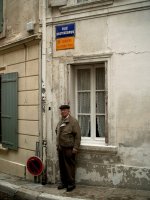
I knew he would
stand there.
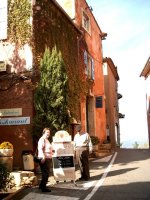
Still looking for
a place to eat.
|
As predicted, Day 1 was dreary. My
contingency plan for rain was to take my guests to Cavaillon,
a place I had really spent little time, and to visit the
laverie to do my laundry. Iím sure youíll agree
that watching someone do laundry is not the primary reason
people come to Provence, but owing to some unfortunate miscalculations,
I had run out of clean socks and was in a spot. After all,
as an emissary of my country, I couldnít exactly go to work
with dirty socks the following week, Franco-American relations
being already strained.
There is not really much to see in
Cavaillon. The Colline St. Jacques, a massive limestone
hill topped by a chapel, dominates the city which was once
a Roman outpost called Cabellio. The only Roman remnants
that remain are some arches conveniently reassembled by
the tourism office. So it was here that I parked, and walked
with my parents and my dirty laundry through the streets
in search of a laverie. There are three laundromats
in Cavaillon (try finding that little nugget in the guidebooks)
and I had already scouted them out, deciding on the newest.
Once I had claimed two washers and inserted the requisite
Ä3.50 per machine, the Flinns retired to that most comfortable
of surroundings Ė the nearest bar. My mother got her first
café au lait of the trip, while my father
and I tried some of the local bières à
pression (draught beers).
In retrospect, the rain gave us an
opportunity to chat for a long while without trying to keep
up with a hectic pace of attempting to see as many places
as possible. My parents were real troopers and even pitched-in
with the laundry. While my father funded and oversaw the
operation, my mother and I provided the labor. It was reassuring
to find out from my mother that at 36 years old, I still
donít know how to fold my clothes properly.
We lunched at a restaurant near the
Roman ruins called La Fin du Siècle (Turn
of the Century), an ornately 1900ís-syle decorated establishment,
where my tagliatelle carbonara was served topped
with a raw egg on the half shell. Coming from a country
where itís becoming more difficult to order eggs sunny-side
up or where dishes involving hollandaise sauce are accompanied
by warnings on the menu, I was slightly stunned at the sight.
Unfazed, my mother said ďMix it in and it will cook in the
hot pasta.Ē I followed the directions and it was in fact
a very delicious pasta dish. But with each bite, my mind
was on one thing - salmonella.
We returned to Eygalières
where I dropped off my laundry and showed the folks around
my new room and then to town. After walking around Eygalières
and enjoying some of the local wine, we discovered a problem
that was to plague us for the rest of the long weekend.
Not surprisingly in the parts of Europe surrounding the
Mediterranean, people tend to eat larger lunches, take siestas,
and then nosh on lighter fare for dinner much later in the
evening after the baking sun has set. This custom is carried
through to the winter even though the sun sets just after
5 pm. I hadnít really noticed it because Iíve been getting
most of my meals from the grocery store and have only eaten
in restaurants during lunchtime on the weekends. What this
boils down to is that once the lunch ends, nothing is open
to serve food again until 8:30 pm at the earliest. Needless
to say, we spent a great deal of time looking for something
to eat around our more customary dining time. |
|
|
|
As the weather looked to improve,
I decided to venture into new territory. To this point,
I had spent most of my time in the Bouches-du-Rhône
region east of the Durance. With my guests packed into the
Twingo, we drove into the substantially more mountainous
Vaucluse region to the west. I thought it best to subject
my father to the more elevated areas early and get it out
of the way. To my surprise and relief, he was a trooper
throughout the day and only spoke up on one particular stretch
of mountain road.
The Vaucluse is littered with villages
perchés (perched villages) but none is as celebrated
or as lovely as Gordes. Itís in all the guide books and
postcard racks and is a required stop for all tour buses
in the region. The reasoning behind building cities on these
hillsides is obviously security. In fact, most of these
hilltowns have châteaus at the summit and many had
walls to deter intruders. Gordes, for example, had near
vertical staircases as its only means of access.
One of the fortunate things about
traveling in November is the lack of tourists. Certainly,
Gordes would be seething with visitors in the summer, but
we pretty much had the run of the place. The
real problem with Gordes, in my humble opinion, is that
it looks great from a distance, but thereís not much to
it once you get there. My parents agreed, remarking that
it didnít have the charm of Mont St. Michel or even Les
Baux, which we had visited earlier.
|
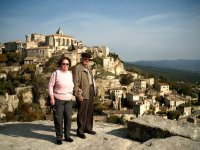
A missed opportunity.
She'll never get him that close to the edge again.
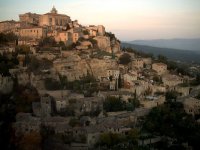
Gordes at sunset.
|
|
|
| 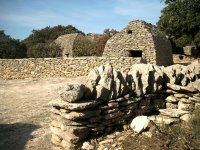
The village des
bories near Gordes.
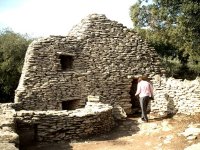
Meet the Flintstones.
|
Dotting the landscape around the
Luberon range are stone huts built in the pierres sèches
(dry stones) style, that is they are constructed without
mortar or binder. These bories are constructed
with overlaying flat stones to ward off rain, and the thick,
air-filled walls provide an almost constant inside temperature
year-round. An average-sized borie can contain
200,000-300,000 stones.
While there are some five to six
thousand bories in Provence, most are found scattered
here and there throughout the landscape. The village
des bories outside of Gordes is the largest concentration
of bories in the region. These dry-stone huts are
not unique to Provence nor are they necessarily old. A museum
at the village des bories shows pictures of similar
structures from all over the globe Ė Africa, Italy, California,
and South America. The folks saw similar dwellings in Ireland
that date back to the Neolithic period. Those in the village
des bories were used up until 150 years ago. Others
are still used by shepherds to overnight in as they move
their flock among the pastures.
.
|
|
|
|
Pick up any book on Provence and there will be a picture
of the abbey at Sénanque. Iíve seen it on the cover
of several. What makes this 12th century Cistercian monastery
so appealing is that it sits as an island amid a field of
lavender. It must be a stunning sight to behold in the summer.
Iíll have to come back someday to see it.
|
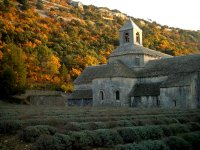
L'Abbaye de Sénanque
amid rows of shrubs.
|
|
|
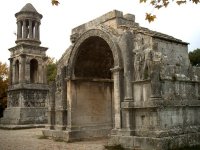
Les Antiques - Roman
mausoleum and triumphal arch.
|
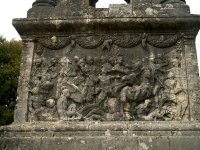
Bas-relief of Roman
soldiers cracking some French heads.
|
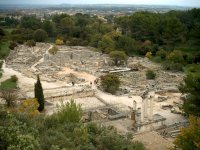
Looking toward North
Glanum with St. Rémy in the background.
|
|
| 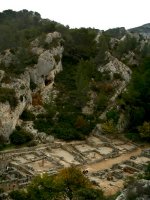
View of South Glanum
and the Alpille boundary.
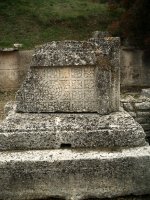
Preserved floral
decorative patterns.
|
On the road leading out of St. Rémy
in the direction of Les Baux, one canít miss the assuming
presence of two large Roman structures. Les Antiques
as they are called stand just to the side of the road like
some sort of ancient reststop dating from 30 AD. The taller
of the two is a mausoleum with surprisingly well-preserved
bas-reliefs of Roman warriors engaged in combat with Gallic
counterparts. Contained in the cage-like upper portion of
the tower are statues of Caesar and Augustus. The triumphal
arch adjacent to the mausoleum has succumbed to slightly
more erosion over the last 2,000 years, but one can still
make out the reliefs of Gallic male and female prisoners.
A nearby sign states that the scenes depicted on les
Antiques are quite rare in that it is unusual to find
images of Gallic warriors or prisoners anywhere.
Les Antiques stood alone
for some time until a couple of French archeologists began
digging into the alluvial deposits at the base of the Alpilles
several hundred yards away. They eventually discovered an
entire city that mirrors the ancient history of the Gallic
people themselves. The settlement of Glanum, so named after
the diety Glanis who the original inhabitants worshipped,
is originally Celto-Ligurian but the earliest remaining
structures were built by Gallo-Greeks, possibly originating
from Marseille between the 2nd and 1st centuries BC. The
access to a mountain pass to Marseille and a hot spring
to provide potable water made this both a strategic and
desirable site. From the 1st century BC to the 3rd century
AD, the site fell under Roman rule and was expanded. Consequently,
the ruins are an interesting mix of large stones preferred
by the Greeks and smaller more exact-fitting stone used
by the Romans.
The Romans also made use of the spring
by channeling the water underneath the town to heat homes
and supply the ubiquitous Roman baths. Inscriptions on some
of the ruins can be found in both Greek and Latin as well
as preserved decorative patterns. In fact, a wall of a dwelling
has been excavated which still has remnants of the original
painted plaster. A partial reconstruction of one of the
Greek temples was recently completed including copies of
the original capitals. The numerous artifacts recovered
from the site are displayed at St. Rémy in the Hôtel
de Sade, a one-time residence of the famed Marquis de Sadeís
extended family. |
|
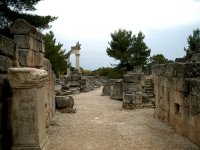
A view down Main Street
and the partially reconstructed Greek temple. |
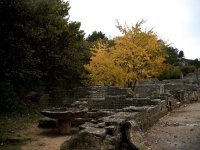
Roman dwelling and
fountain. |
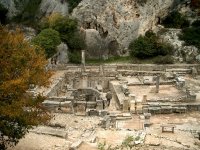
Dad, visibly comfortable
around things older than himself, checks out the spring at
Glanum. |
|
|

